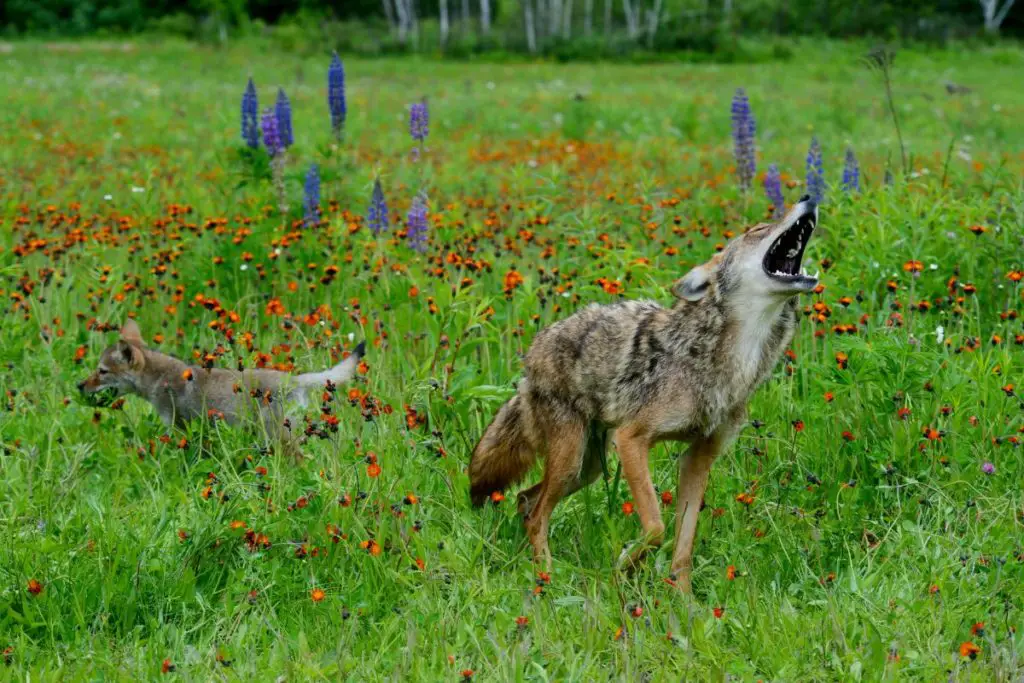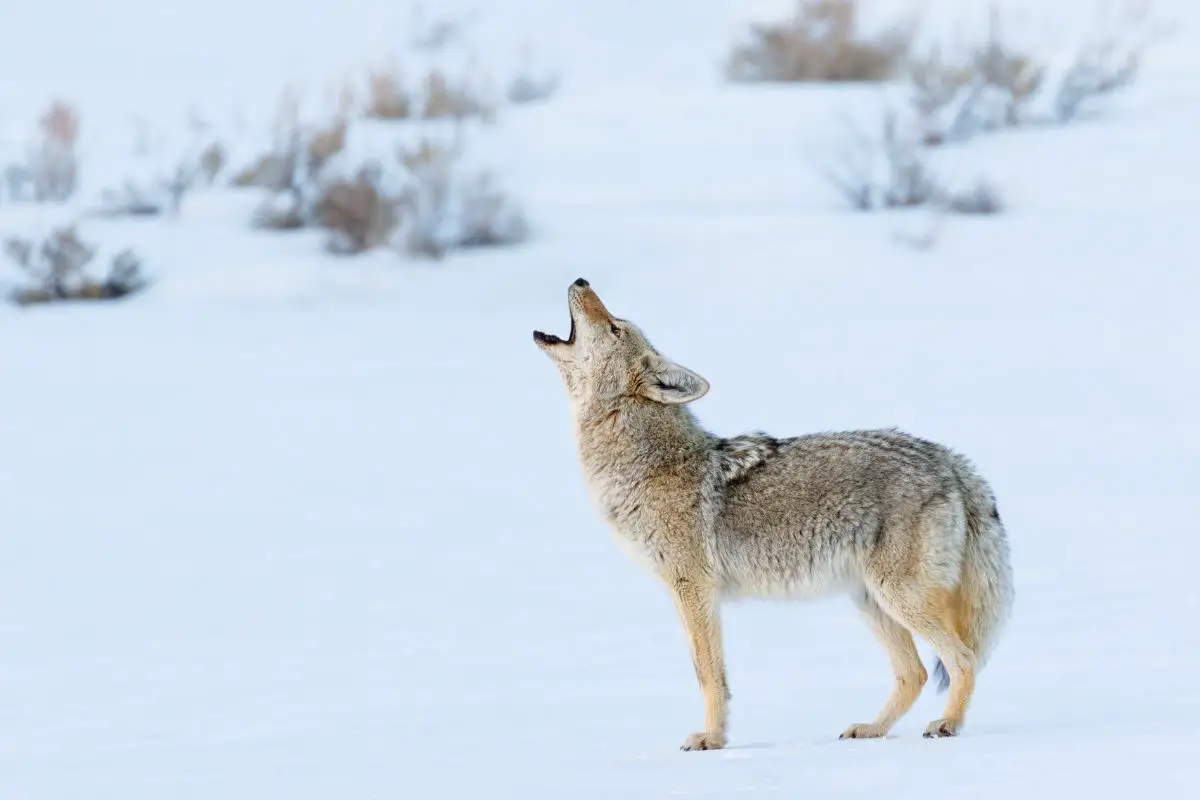If you’ve found your way to this page, you’re probably wondering what kinds of sounds and noises a coyote makes. You have probably even heard a coyote at least once in your life.
Just because you can hear a coyote doesn’t necessarily mean they are as close as you think. We’re going to go into detail about the sounds coyotes make, and why they make them.
What Does a Coyote Sound Like?
Coyotes make many different sounds to communicate including howling, yipping, yelping, woofs, and barks, as well as many others, depending on their mood and the circumstances. While this is not their only means of communicating, it is an important part of the dynamic between family members, transient coyotes, and other animals that they come in contact with.
You can tell a lot about a coyote or a group of coyotes by listening. Coyotes can be heard at any time of the day or night and can sometimes be confused with other animals. Notably, coyote sounds can often be confused with those of foxes, dogs, and wolves. They can even be confused with the sounds of certain owls.
How Coyotes Communicate
To convey specific intentions, coyotes communicate in several ways between each other and other members of the animal kingdom that they come across. Obviously, they communicate through vocalizations.
This is the method that we are most familiar with. Other methods include scent marking and visual means through body language. The latter being their primary communication method among themselves.
When it comes to communicating vocally, a lot is going on there. Coyotes’ voices are uniquely their own. Between pack members, they can be easily recognized by one another. Source.
Why Coyotes Communicate
The ability of coyotes to communicate is a necessary element in their day-to-day affairs, especially their family life. While most coyotes like to hunt alone, their family members are always nearby.
This is because their “pack” is made up of family members. Within the pack, coyotes use their vast array of sounds to communicate their location, gain attention or create avoidance, or express distress.
In addition to their interpersonal communications with each other, coyotes give audible cues to ward off other predators that may roam into their territory. Especially if they have pups.
Coyotes are less likely to be seen in the spring and summer. This is because they limit their movements to a smaller area while they birth and rear their pups. During this time, they are likely to be more confrontational as they protect their new arrivals. Source.
Coyote Sounds Meaning
Now that we have a general idea of how coyotes communicate and why, let’s get into some of the specific sounds and their meanings.
| Growl |
| Similar to that of the domestic dog and the wolf, coyotes growl for many of the same reasons. A howl is meant as a warning to other animals or to establish dominance within their pack. |
| Bark |
| Barks are usually meant to warn others of danger. They are also used with growls for similar reasons. Or, as we stated earlier, they can be used to gain attention or create avoidance. |
| Huff and Woof |
| Both of these can be used to express displeasure and dislike for other coyotes and dogs that intrude in another’s territory or between pack members. |
| Lone Howl |
| The lone howl is usually communication between pack members for location, so members of the pack can keep track of each other. |
| Bark Howl |
| The bark-howl is usually meant to drive off intruders. It simply means “go away”. |
| Whine and Yelp |
| These types of vocalizations are common with pups and beta members of the pack and can be used along with visual cues such as tucking their tale. Also, you will hear these sounds from coyotes who are injured. |
| Group howl / Yip-Howl |
| This group interaction is meant mostly as a territorial display. It is also used to promote bonding within the family group. |
Coyote Sounds At Night
Coyotes are primarily nocturnal. This is especially true in areas where they are exploited by humans. We often hear Coyotes at dusk and right after sunset.
Because coyotes only use their dens when rearing pups, individual coyotes usually do not sleep in the same place. For this reason, the alpha male will usually call his group together just as the last light of the day is fading into the night to get their “day” started.
After this interaction, they will break up to hunt individually or in loose pairs. During late summer, fall, and winter, not restricted by their parental duties, they will roam a larger area and will often howl individually to convey their location to one another. Additionally, this serves to mark their territory, serving as boundaries from other packs and transient coyotes.
When we think of howling we generally associate it with the moon. The lunar phases do affect how vocal a coyote or group of coyotes will be. But unlike what we may picture in our minds, coyotes do not howl at the full moon.
Actually, the opposite is true. Coyotes howl more during times when there is little or no moonlight. Once again, howls serve to determine location, which is more necessary on nights with low light.
See our article for When Do Coyotes Howl
Coyote Mating Sounds
Usually between late January and early March, depending on geography, you will hear a greater activity of coyote vocalizations. This is because it is the breeding season. Coyotes are monogamous, forming strong pair bonds. Remaining monogamous until one of the mating pairs dies.
The particular song you get at this time of year from this North American “song dog” is the alpha pair courtship which can last several months before copulation. The male will howl with the female adding in her barks, yips, and short howls. Beta coyotes will often join in. Other nearby pairs may then respond by announcing their territories.

Weird Coyote Sounds
Understanding the different sounds that coyotes make can be very useful. Although this may be true, this can sometimes be difficult to do. This is because the amount of vocalizations used by the coyote is probably the largest of all North American mammals, save for one, people. Not to mention these animals use some vocalizations that you would not expect from them.
Coyote’s yips, barks, and short howls can often sound like laughter. Also, when in severe distress, usually because of a perceived threat by a large predator, coyotes will make a screaming sound. Similar to a woman screaming, this sound can be most unsettling. Other animals make this or a similar sound such as foxes and bobcats.
Want to learn more about animals Check out Are Salamanders Poisonous
Related Questions
Do coyotes make sounds when killing?
Coyotes are stealthy hunters. They do not howl or bark before or after a kill. When coyotes are hunting together they may communicate with each other in an attempt to coordinate their efforts. However, these interactions will be brief so as not to gain attention from other predators.
What does a coyote in distress sound like?
Coyotes can make many sounds when in distress. Some of these sounds include a bark, yelp, scream, and whine. Growls and barks may also signal a coyote in distress.
- Writing a Eulogy for Your Pet: Honoring Their Memory - July 1, 2024
- How to Introduce a New Dog to Your Home as a Senior - July 1, 2024
- Daily Routines: How Dogs Help Seniors Stay Structured - July 1, 2024


